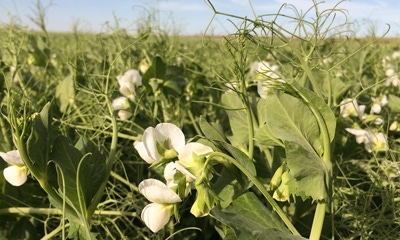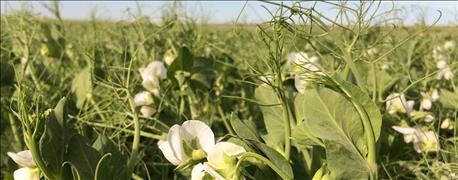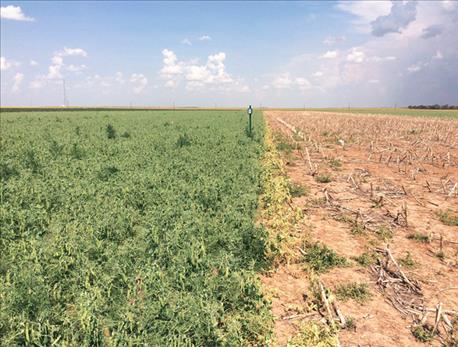July 28, 2016

Grain-type field pea (Pisum sativum) — also known as field peas, yellow dry peas or yellow peas — is a spring-planted, cool-season crop that can be grown as an alternative to summer fallow in semiarid cereal-based cropping systems. The agronomic potential and rotational benefits of field peas have long been observed by dryland farmers in semiarid regions of Colorado, Kansas, Nebraska and Wyoming. However, lack of market opportunities and locally developed research-based recommendations on agronomic practices have hindered larger adoption of the crop in these regions. As these information gaps are gradually addressed, field pea production is increasing in the western High Plains.

PEAS IN BLOOM: A western Nebraska field of field peas blooms. (Photo credit: Strahinja Stepanovic)
Developing local Nebraska markets for field peas
In 2016, farmers planted approximately 35,000 acres to field peas in northeast Colorado, northwest Kansas and southwest Nebraska (estimate based on seed sales) without a guaranteed market. In response, Gavilon Goodlife Grains and Pulses created local field pea markets and, it reports, invested about $9 million in pea processing and storage facilities in the region. It is now buying field peas in Nebraska, Kansas, Colorado, Wyoming and South Dakota, offering spot contracts, new crop contracts, storage premium contracts, farm pickup contracts, delivered contracts and acre contracts to field pea growers. Gavilon has five receiving points in Nebraska: Benkelman, Champion/Imperial, Cozad/Lexington, Kearney and Hastings. Many producers are using on-farm storage and marketing their peas through a number of brokers in addition to Gavilon.

PEAS VS. FALLOW: An on-farm research study in Chase County is comparing field peas and fallow ground. (Photo credit: Strahinja Stepanovic)
In 2012, there was a similar grower initiative in the Nebraska Panhandle, and Stateline Producers Cooperative in Bridgeport and Gering responded by developing local markets and investing in a pea processing facility. Since then, field pea acreage in Nebraska has increased from 10,000 acres to about 100,000 acres, mostly due to larger adoption of field peas in the Nebraska Panhandle.
Researching field peas for long-term sustainable production
Faculty and staff from the University of Nebraska-Lincoln, Kansas State University and Colorado State University are working closely with farmers and stakeholders to bridge some of the information gaps around growing field peas in semiarid dryland cropping systems. The universities cited are collaborating on research on field pea production in the western High Plains with funding support from their institutions, USDA's SARE (Sustainable Agriculture Research and Education) program and the field pea seed industry (the pictures with this article are from field days).
Although in the early stages of research, and multiyear and multilocation data has yet to be analyzed and published, here are preliminary research findings from UNL's 2015 rotation study that may help you make informed decisions on replacing fallow ground with field peas:
• Field peas had higher soil microbial activity than fallow. The release of the plant-available nitrogen through mineralization of soil organic matter was estimated to be about 20 pounds per acre higher than in fallow.
• Field peas had better water utilization than fallow. Field peas produced a 36-bushel-per-acre yield using 11 inches of soil water (3.3 bushels per acre-inch) and allowed enough time to refill the soil water profile with off-season rains to ensure good winter wheat establishment. Fallow used 6 inches of soil water while producing nothing, and did not have enough soil water storage to capture 5.3 inches of additional rain that was leached out below the root zone (4 feet).
• Field peas supported a greater number of beneficial insects and microorganisms than fallow.
• Field peas were more profitable than fallow, about $111 per acre.
• The trade-offs are that field peas may deplete soil water and potentially reduce the yield of succeeding wheat crops (the yield penalty is 5 to 6 bushels per acre-inch), especially in dry years.
The following parameters are yet to be evaluated in this rotation study:
• Yield and yield quality of a succeeding wheat crop
• Mycorrhizal associations in a succeeding wheat crop
• System profitability
• Soil water infiltration
• Soil aggregation (erosion potential)
Research results of field peas' yields and variety testing performance are available for multiple years and locations. Seeding rate studies, in-furrow fertility treatments, seeding depth, inoculant and herbicide studies have yet to be analyzed and published.
Future of field peas
Research results will continue to be released at university workshops and field days, and through the media to close the information gap related to producing field peas on the western High Plains. Farmers, consultants and members of the agriculture industry have attended many of the educational events that have been conducted in the region and can expect more releases as information becomes available from this season.
With prices of other crops (wheat, corn and sorghum) being volatile and the cost of production constantly increasing, having an additional, low-input legume crop with a stable market might benefit growers, certified seed dealers, field peas processing facilities and communities in general.
2016 — International Year of Pulses
The 68th United Nations General Assembly declared 2016 the International Year of Pulses to raise awareness of field peas and other pulse crops (lentils, dry beans and chickpeas) as highly nutritious, having important health benefits, contributing to climate change mitigation and adaptation, promoting biodiversity and sustainable agriculture, and being economically accessible and contributing to food security at all levels. Due to these characteristics, pulses have been called a "superfood of the future" and fundamental to helping end world hunger while protecting the environment.
Source: UNL West Central Research and Extension Center
You May Also Like




